Smart Bookkeeping for Architects: 5 Tips to Get Paid Faster

In an ideal world, every minute of an architect’s work day would be spent doing what they love: helping people bring ideas to life. But for self-employed architects or those who are part of a smaller firm, there’s just no way around the fact that they must dedicate at least part of their time to the activities that support their business—like bookkeeping.
 Proper bookkeeping gives you visibility into the money going in and out of your business. Without this information, it’s next to impossible to know your true profitability since you don’t know how much you’ve spent, been paid, or are still owed.
Proper bookkeeping gives you visibility into the money going in and out of your business. Without this information, it’s next to impossible to know your true profitability since you don’t know how much you’ve spent, been paid, or are still owed.
In this article, we’ll discuss five strategies for accurate bookkeeping for architects to help you keep your accounts current and reduce your collections burden.
Optimize the Client Experience
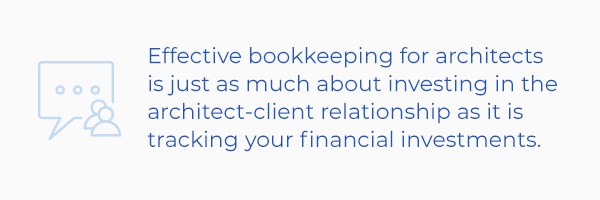 Your commitment to the client experience has an impact on more than just your business development endeavors. Because you’re a professional services provider, the quality of your communications and interactions with clients can influence multiple KPIs, including how quickly you receive payment for those services.
Your commitment to the client experience has an impact on more than just your business development endeavors. Because you’re a professional services provider, the quality of your communications and interactions with clients can influence multiple KPIs, including how quickly you receive payment for those services.
This is why if you want to decrease the time between when you send an invoice and when you can mark it as paid, you need to determine how you can improve your client experience. Here are three quick tips:
- Ensure all parties are on the same page from day one by thoroughly reviewing project details during your first meeting
- Maintain open lines of communication throughout the project and make an effort to use the client’s preferred method of communication (phone call, email, or text)
- Adhere to the client’s budget as closely as you can and discuss the potential need for increases as soon as you identify them
Effective bookkeeping for architects is just as much about investing in the architect-client relationship as it is tracking your financial investments.
Lean on Your Contract
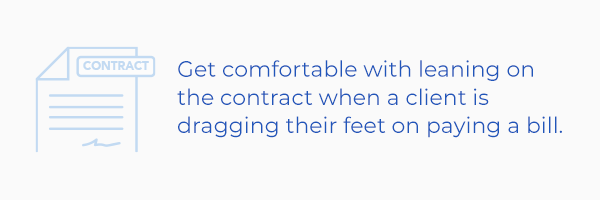 Since most clients won’t hesitate to bring up the terms of the contract in the event of a disagreement, get comfortable with leaning on the contract when a client is dragging their feet on paying a bill.
Since most clients won’t hesitate to bring up the terms of the contract in the event of a disagreement, get comfortable with leaning on the contract when a client is dragging their feet on paying a bill.
Start by including language that stipulates penalties for late or missed payments, such as a flat fee or percentage of the statement’s total for every day the account is in arrears. Then, as long as you’re delivering what you promised, it’s not unreasonable to politely remind clients about the agreed-upon payment terms.
The emphasis here is on “politely”. If the client is usually good about taking care of their invoices and misses a payment one month, they might just need a small nudge. However, if late or non-payments become a habitual challenge and you’re having difficulty reconciling your books due to the number of outstanding invoices, feel free to copy and paste the terms of your contract into an email and remind them that non-payment can lead to even more costly project delays.
Most importantly, don’t be afraid to stop working on a project if a client has multiple unpaid invoices. You need to advocate for yourself; you’re a professional who deserves to be paid for their work.
Hire a Professional Bookkeeper
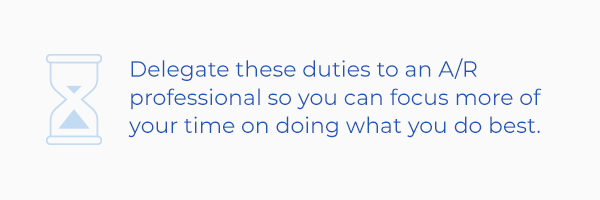 If you’re a solo practitioner or part of a smaller firm, all financial record keeping duties fall entirely (or at least partially) on your shoulders. Since efficiently handling the responsibilities associated with bookkeeping for architects can be a job in and of itself, you may want to think about hiring a professional to manage your accounts receivable (A/R).
If you’re a solo practitioner or part of a smaller firm, all financial record keeping duties fall entirely (or at least partially) on your shoulders. Since efficiently handling the responsibilities associated with bookkeeping for architects can be a job in and of itself, you may want to think about hiring a professional to manage your accounts receivable (A/R).
You can certainly try to manage it yourself, but one of the primary goals of bookkeeping is to understand the financial health of your business, and if you have to dedicate a large chunk of your time every month to completing A/R tasks, you lose out on time to actually use this insight.
And consider this: the money you save by keeping A/R management in house is potentially less than what you could earn from the additional projects you’d have the time to secure by outsourcing the job to someone who is an actual expert in bookkeeping for architects. So instead of missing out on opportunities to bring in more clients, delegate these duties to an A/R professional so you can focus more of your time on doing what you do best.
Simplify Your Billing
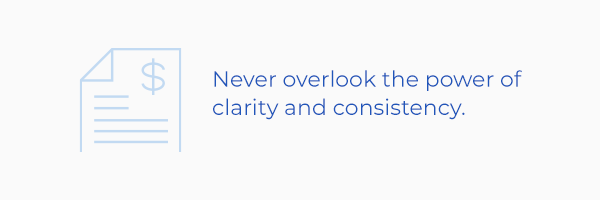 Because clarity and consistency are at the heart of excellent bookkeeping for architects, you should embrace these two qualities as integral to any finance-related activities—in particular, your billing practices.
Because clarity and consistency are at the heart of excellent bookkeeping for architects, you should embrace these two qualities as integral to any finance-related activities—in particular, your billing practices.
While there are occasions where payment delays are legitimately unavoidable, what some professional service providers don’t realize is that they may inadvertently be contributing to slower payments by overlooking the power of clarity and consistency.
When a client receives an invoice with a brief description for each line item, written using terminology that anyone outside the AEC industry can read, she is much more likely to understand what she’s being charged for and remit payment immediately. On the other hand, if she receives an invoice with a single charge for “Services rendered in January” or one containing so many acronyms and abbreviations that it might as well be written in another language, she’s more likely to email a request for clarification than send a payment.
With clarity covered, it’s time for consistency. If you send invoices at regular intervals and ensure there is not a large gap between when you’ve completed the work and when the client receives the bill, then your clients know when to expect the invoice each month and can budget accordingly.
Take Advantage of Technology
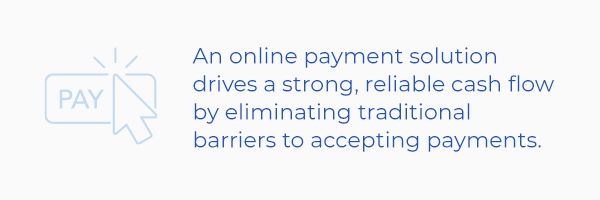 It’s almost unfathomable to imagine completing an architectural design project without technology like CAD and BIM solutions. Yet, many architects still take an outdated approach to invoicing and accepting payments. And in 2021, there really is almost no valid argument for not using an online payment solution to accept and manage payments.
It’s almost unfathomable to imagine completing an architectural design project without technology like CAD and BIM solutions. Yet, many architects still take an outdated approach to invoicing and accepting payments. And in 2021, there really is almost no valid argument for not using an online payment solution to accept and manage payments.
A secure, web-based payment processor like ClientPay enables you to provide more flexible and convenient payment options and a more professional payment experience (that is also safer since it facilitates social distancing).
With tools like Scheduled Payments, you have the ability to offer prospective clients payment plans with automatic recurring billing. You can also add custom Payment Links to your website, emails, and even text messages to make it easy for clients to view and pay invoices from anywhere.
In short, an online payment solution drives a strong, reliable cash flow by eliminating traditional barriers to accepting payments. And a reliable cash flow is absolutely essential to effective bookkeeping for architects.